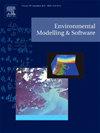A systematic review of machine learning in groundwater monitoring
IF 4.6
2区 环境科学与生态学
Q1 COMPUTER SCIENCE, INTERDISCIPLINARY APPLICATIONS
引用次数: 0
Abstract
With increasing concerns about water scarcity, groundwater has become crucial since this resource provides most of the freshwater needs. However, various human and natural activities often contaminate the groundwater, making it unsuitable for use. Over the years, scientists and engineers have used many methods to predict and track groundwater contamination as part of environmental monitoring. Consequently, there is an urgent need for improved methods, particularly in the face of increasing contamination. Machine learning has sometimes been used to monitor groundwater, air quality, and climate. Traditional methods must be improved due to the complexity and large amount of environmental data. This includes using hybrid models that combine traditional and new techniques. Despite the use of machine learning in many scientific areas, there is a lack of comprehensive reviews focusing on its use in environmental monitoring, especially groundwater monitoring. We aim to fill this gap by exploring machine-learning applications in groundwater monitoring. We discuss relevant methods, their limitations, and future potential. We summarize research on automating data processing and model training using groundwater sensor data. Our research underscores the transformative potential of machine learning to revolutionize long-term groundwater monitoring and contamination detection, providing valuable insights for future research and practical applications.
地下水监测中机器学习的系统综述
随着人们对水资源短缺的日益关注,地下水变得至关重要,因为这种资源提供了大多数淡水需求。然而,各种人类和自然活动经常污染地下水,使其不适合使用。多年来,作为环境监测的一部分,科学家和工程师已经使用了许多方法来预测和跟踪地下水污染。因此,迫切需要改进方法,特别是面对日益增加的污染。机器学习有时被用于监测地下水、空气质量和气候。由于环境数据的复杂性和海量性,传统的方法必须加以改进。这包括使用结合传统和新技术的混合模型。尽管机器学习在许多科学领域使用,但缺乏对其在环境监测,特别是地下水监测中的应用的全面审查。我们的目标是通过探索机器学习在地下水监测中的应用来填补这一空白。我们讨论了相关的方法,它们的局限性和未来的潜力。总结了利用地下水传感器数据进行数据处理和模型训练的自动化研究。我们的研究强调了机器学习在改变地下水长期监测和污染检测方面的变革潜力,为未来的研究和实际应用提供了有价值的见解。
本文章由计算机程序翻译,如有差异,请以英文原文为准。
求助全文
约1分钟内获得全文
求助全文
来源期刊

Environmental Modelling & Software
工程技术-工程:环境
CiteScore
9.30
自引率
8.20%
发文量
241
审稿时长
60 days
期刊介绍:
Environmental Modelling & Software publishes contributions, in the form of research articles, reviews and short communications, on recent advances in environmental modelling and/or software. The aim is to improve our capacity to represent, understand, predict or manage the behaviour of environmental systems at all practical scales, and to communicate those improvements to a wide scientific and professional audience.
 求助内容:
求助内容: 应助结果提醒方式:
应助结果提醒方式:


